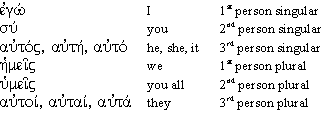
This chapter is about identifying who is doing what in a sentence. It is one of the longer chapters in this grammar, and there is a lot to memorize, but it is an extremely important chapter for several reasons:
Nevertheless, this chapter may be too long to swallow in one gulp. You may want to work through one section at a time, and make sure that you master each section before moving on to the next. Here are some basic concepts that we will be discussing:
Nounsare words that describe people, places, or things. Here are some English nouns: book, person, chewing-gum, country, county, city, road, field, justice, peace, language, concept, man, woman, god, programmer, linguist. We will actually postpone nouns until the next chapter, since it is easier to explain certain features of Greek pronouns first.
Pronounsare words that "substitute" for nouns, referring to people, places, or things that are known in the given context. Here are some English pronouns: I, you, he, she, it, we, you all, they.
Casesare the forms that words like nouns and pronouns take to tell you, among other things, who is doing what to whom and for whom, and who owns what. We will be talking about the nominative, genitive, dative, and accusativecases.
Here are the Greek personal pronouns:

A few mnemonics may be helpful here:
In the above table, we translated autoV, auth, and autoas "he", "she", and "it". This is a useful oversimplification, but the gender of a pronoun does not necessarily mean that a male, a female, or an "it" is intended. If you recall, in lesson one we pointed out that every noun has a gender, and this gender is somewhat arbitrary:
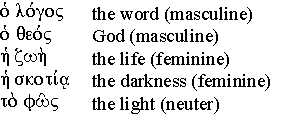
In Greek, it would be quite normal to say something like, "the light shines in the darkness, and she has not overcome it"; because darkness is feminine and light is neuter, "she" would have to refer to the darkness, and "it" would have to refer to the light. Naturally, we wouldn't want to use "she" and "it" in an English translation of this sentence! Whenever you see a pronoun, you have to figure out what it is referring to before you can translate it. Therefore, "he", "she", and "it" are somewhat misleading. It is more accurate to call autoV, auth, and autothe masculine, feminine, and neuterforms.
However, in most cases, if we wanted to translate the English word "he" into Greek, we would use the wordautoV, and if we wanted to translate the English word "she" into Greek, we would use the word auth, and many times these Greek pronouns do mean "he" and "she".
In Greek, the pronoun "they" also has gender -autoi, autai,and autaare really the plural forms of "he", "she", and "it". In English, we use one word, "they", when we refer to a group of "hes", a bunch of "shes", or a bunch of "its", but Greek has separate forms for each. Once again, the terms "he", "she", and "it" are misleading - in Greek, a girl or a mother-in-law are neuter, not because they are not female, but because that happens to be the gender of the nouns used to describe them. It is always worth remembering that "it" can often be the best translation of a masculine or feminine pronoun. When translating into Greek, remember that you do not know the right form for "it" or "they" until you know the gender of the noun. The following table, suggested by Tony Prete, may help you keep this in mind:
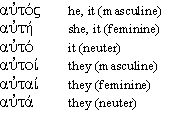
Now it is time to learn these pronouns, and we will do it with our famous flashcard gizmo. A few quick notes:
Practice this until you have the forms down:
And now let's try translating from English into Greek:
In Greek, both nouns and pronouns take different forms to tell you whether they are being used as subjects or objects. In many cases, the form of the noun or pronoun is the only way that you can tell who is doing something, to whom it is being done, for whom it is being done, etc., so it is extremely important to learn these forms!
Before we discuss the Greek forms, it is important to understand how subjects and objects work in general, and we will start by using English examples. Make sure that you learn any term that appears in bold face. Here are afew everyday English sentences:
The pronoun changes form to tell you who is hitting and who is being hit. In every case, "he" or "I" refers to someone who is doing the hitting, and "him" or "me" refers to someone who is being hit. Sentences 3 and 4 may or may not strike you as weird unless you grew up in a community where English usage was influenced by German, Yiddish, Norwegian, Swedish, etc., but the meaning is still clear. (Where I grew up, about half the population was Swedish, but my wife cringes when I say things like this. Nevertheless, she understands what I mean!)
The point that I'm trying to make is that these pronouns change form to show what function they play. The verb in this sentence is "hit". This verb has a subjectand an object:
| Verb | hit |
| Subject | I |
| Object | him |
Not all verbs have objects. "Jesus wept" is a complete sentence without an object. A verb which has an object is called a transitiveverb. A verb which does not have an object is called an intransitiveverb. Some verbs can be used with or without an object:
There are actually two kinds of objects, direct objectsand indirect objects. Let's illustrate this by analyzing a sentence:
| I | gave | her | the book | |
| subject | verb | indirect object | direct object | |
The subjectanswers the questions "who gave" or "what gave"; the answer is "I gave", so "I" is the subject. In general, for a verb V, the subject answers the question "who V?" or "what V?".
The direct objectanswers the questions "whom did I give" or "what did I give"; the answer is "I gave the book", so "the book" is the direct object. In general, for a verb V with subject S, the direct object answers the question "whom did S V?" or "what did S V?".
The indirect objectanswers the questions "to whom did I give", "for whom did I give", "to what did I give", or "for what did I give"; the answer is "I gave the book to her", so "her" is the indirect object. In general, for a verb V with subject S, the indirect object answers the questions "to whom did S V?", "for whom did "S V?", "to what did S V?", or "for what did S V?".
The passive transformis a useful trick you can use to see whether an object of a transitive verb is direct or indirect. If you change the verb to passive, the subject becomes a direct object, the direct object becomes the subject, and the indirect object remains an object. Consider these sentences:
| I | gave | her | the book | |
| subject | verb | indirect object | direct object | |
| the book | was given | to her | by me | |
| subject | verb | indirect object | direct object | |
Because "her" remains an object when you change from active to passive, it is an indirect object. "The book" becomes the subject when the verb is made passive, so it is a direct object.
In Greek, the subject, direct object, and indirect object are identified by the case of the pronoun, and pronouns change their form to tell you what case is being used. Let's explore this using a Greek sentence:
How do we know that this says "David called him Lord", and not "He called David Lord"? As a native English speaker, your first instinct is probably to say that it is the word order, but we can change the word order around without changing the subject of the sentence:auton legei autoV Dauid kurionwould mean "him called David Lord", which is very questionable English but perfectly legitimate Greek. By putting "him" at the front of the sentence, the emphasis would be switched to "him", but David is still the person who calls "him" Lord.
The word order does not tell us who was called Lord; the form of the pronoun does. autonmeans "him", autoVmeans "he". A "him" can't be the person who is doing the calling, only a "he" can. Here are the forms that autoVtakes as subject, direct object, and indirect object:

Why doesn't our sentence mean "David said tohim, Lord"? Because "said to" would require an indirect object, which would be autw. David didn't say "to him" Lord, he "said him" Lord (direct object). In English, we would say that David "called him" Lord.
There is one more case. The genitivetells us who owns what. If I say "his house", the word "his" is genitive, and tells me that the pronoun is being used to tell me who owns the house.
Here are the Greek personal pronouns in all possible cases - there are too many to memorize all at once, so we will learn them one step at a time:
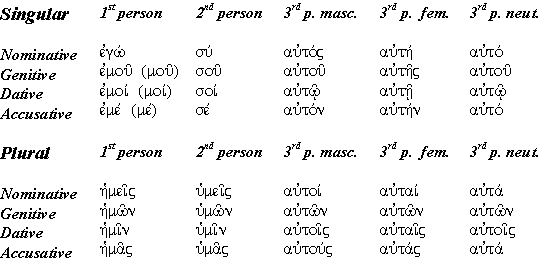
Now let's explore these cases one at a time.
The forms of the pronoun that we learned at the beginning of this lesson are all nominative, which is the form that a pronoun takes when it serves as the subject of a verb. For instance, here is a verse we have already encountered, John 9:35:
As we have mentioned before, the verb already states that the subject is "you", and does not really need the pronoun; when a pronoun appears, it emphasizes the subject: "doyoubelieve in the son of man?"
Agreement:The subject of a verb must always "agree" with the verb. A pronoun and a verb are said to "agree" if they have the same personand number. In other words, if both the pronoun and the verb are talking about "I", they agree; if they are both talking about "we" they agree; if they are both talking about "you all" they agree; if they are both talking about "she" they agree, etc. These tables, which we have already seen, show the person and number for the nominative pronouns and for the forms of the verb blepw:

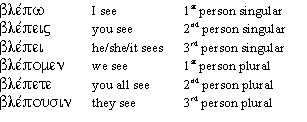
If a pronoun and a verb agree in both number and person, then they are said to agree; if they agree, they may betalking about the same person or thing. If the pronoun is first person and the verb is first person, then they agree in person. If the pronoun is singular and the verb is singular, then they agree in number.
Can you answer these questions?
Using the forms we have learned, supply the missing pronoun in these examples:
"How is it that we each hear in our own dialect?"
"Say I, not the Lord". Note that the pronoun can occur before or after the verb. In English, word order is a very important clue to finding the subject of a verb, but in Greek you can not rely on word order. If a pronoun located near a verb is nominative, and it agrees with the verb, then it is likely to be the subject of that verb.
But also remember that the pronoun is often not stated. legwmeans "I say" even without adding egw; the phrase legw egwuses the pronoun for emphasis: "Isay".
Now let's up the ante a little. In the following examples, both the verb and the pronoun are omitted; your job is to supply both:
kaican mean "also" as well as "and".
Note:Translate "do I say" the same way you would translate "I say". I added the word "the" to bring out the nuance of meaning that it takes in this passage: "neither do I tell you by what authority I do these things." Note that even though the Greek says "in what authority", we say "by what authority" in English.
Note: in the New Testament, Jesus is usually called "the Jesus". When we translate into English, we omit "the". We will discuss this in more depth in a later chapter. For now, ignore that "the".
This is the end of this lesson. The next lesson will continue with accusative, dative, and genitive pronouns.